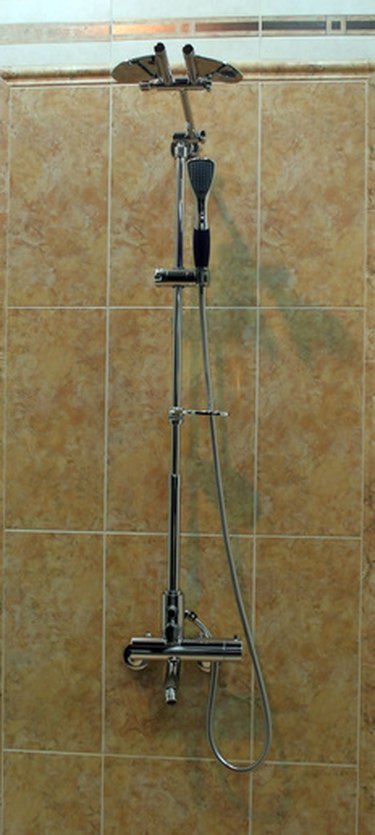Things You'll Need
Epoxy resin (clear or one that matches your tile's color)
Soft microfiber cloths or brush applicators
Natural stone sealant
Cotton buffing cloths

Travertine stone is a natural material similar to limestone. As such it is porous and prone to etching from acidic substances. In spite of these structural considerations, travertine is among the most beautiful and desired types of stone used in modern construction and design. This type of stone is often utilized in kitchens and bathrooms, including shower enclosures. It is highly recommended that wherever travertine is used that it be properly sealed to help protect its surface from damage. Travertine that is correctly cared for will remain attractive for many years. Before attempting to apply sealant, it's necessary that travertine tiles be clean and free from moisture. Set aside two to three days for your tiles to dry after sealing them. The following instructions describe how to easily seal a travertine shower in simple steps.
Step 1
Determine if your travertine tile has been polished or is in its hewn/honed state. If the tile is polished, its surface may look smooth with few natural holes, since its upper layer may have been planed down evenly during the process. Unpolished tiles cut from quarried slabs of rock have more obvious holes of various depths and sizes. If holes are visible, use epoxy resin filler as an additional barrier to keep dirt and impurities from penetrating the stone's top layer before sealing. Brush on a layer of epoxy, using strokes that flow in one direction only, allowing it to fill up any crevices smoothly. Allow it to dry according to the label directions, and repeat a second time. Avoid making the layers very thick. A veneer of epoxy is all that is needed to create a flat surface that will seal well.
Video of the Day
Step 2
Mix the stone sealant well and begin to apply it to the travertine with a microfiber cloth or an applicator brush. As with the epoxy, brush it on moving in one direction only. Concentrate on making smooth, slightly overlapping layers and avoiding drips and streaks. Stop periodically to look at your work from several angles to make sure that you don't miss any areas or add too much or too little sealant in any one section.
Step 3
Wait 15 minutes for the sealant to begin to start drying, then use a dry cloth or applicator brush to buff away any excess sealant. Do this by wiping down or brushing down the tile in the same direction as it was applied, starting with the section that was sealed first and ending with the section where it was applied last. Work carefully and gradually so that you don't leave any areas of stone untreated.
Step 4
Allow the last coat to dry before reapplying a second coat of sealant. Wait several minutes again before dry buffing the sealed tile as before.
Step 5
Allow the entire are to dry completely for 48 to 72 hours. The tiles should remain undisturbed during that time and no water should make contact with them. After this time has passed, the shower can be enjoyed as usual. Make note of the brands of materials and products used in this project for the next time you seal your travertine stone shower.
Tip
Maintain your travertine tile with non-acidic cleansers having a neutral pH of 7. Always use lint-free microfiber cloths, sponges, or mops as you clean travertine.
It is important that you re-seal travertine, cleaning it very well beforehand, at least once a year for the best long-term results following the initial seal.
Warning
Refrain from using soaps, shampoos, or other bath products that contain citrus acids, glycolic acids, alpha-linoleic acids or abrasive components, such as some body scrubs and skin exfoliators.
Video of the Day